Last Updated on January 22, 2024 by Greg Gillson
What are the little brown birds at your feeder? Are they sparrows? Are they finches? Are they wrens? Small brown birds at your feeder are likely to be sparrows or female finches. However, they might be female blackbirds. They might be wrens!
12 common small brown birds
- House Sparrow
- Song Sparrow
- Fox Sparrow
- American Tree Sparrow
- White-crowned Sparrow
- White-throated Sparrow
- Golden-crowned Sparrow
- female House Finch
- female Purple Finch
- female Red-winged Blackbird
- female Brown-headed Cowbird
- Bewick’s Wren
1. House Sparrow
 |
|
Male House Sparrow in breeding plumage
Photo by Greg Gillson
|
 |
|
Female House Sparrow
Photo by Greg Gillson
|
House Sparrow (Passer domesticus)
Range: Introduced from Europe in the mid-1800s, House Sparrows are found across North America from mid-latitudes in Canada south through Mexico. They do not migrate.
Habitat and habits: The primary habitats of House Sparrows are towns, farms, horse stables, strip malls, urban centers. Wherever people live, House Sparrows follow. They nest in crannies in buildings, street lights, barns, as well as nest boxes. House Sparrows form noisy active flocks.
Description and voice: House Sparrows are rather small sparrows. They are broad-bodied and short legged. They have short necks and their heads are rather flat, not showing much of a forehead bump.
Males in breeding plumage (photo above) have gray bodies, rump and tail. The wings are brownish with chestnut tones and one broad white wing bar. In all plumages males have a small black mask and chin; in breeding plumage the black throat extends to the breast. The crown is gray and chestnut extends from behind the eye to the nape and back.
Females and immature birds are dusty drab gray-brown, darker on the back and wings. Again, the underparts and rump are gray. There is a broad pale eyebrow back from the eye.
Their song is an incessant and monotonous series of “chirp” and “chi-rup” notes. Their calls are the same, but individual “chirp” notes, more rapid when excited and in noisy flocks.
Feeder type and food preference: House Sparrows have rather weak feet, so they prefer eating from the ground or on trays on platform and hopper type feeders. House Sparrows eat many types of small seeds. Their favorite birdseed is white proso millet. They also like canary seed and German millet.
Similar species: In towns not likely to be mistaken for anything else. Pairs stay together throughout the year, aiding identification. About the same size and overall gray-brown color similar to House Finches. But House Finches have strongly streaked under parts (see House Finch below).
2. Song Sparrow
 |
|
Song Sparrow
Photo by Greg Gillson
|
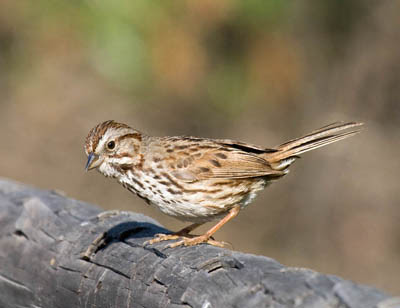 |
|
Song Sparrow
Photo by Greg Gillson
|
Song Sparrow (Melospiza melodia)
Range: Resident in in coastal Alaska and West across the mid-latitudes of the United States. Migratory forms breed north throughout Canada, winter across southern states and into northern Mexico.
Habitat and habits: Song Sparrows inhabit damp and shrubby habitats. They are common in marshes and in backyards landscaped with hedges or larger bushes. Hop on the ground under bushes in gardens. Do not form flocks, but can be numerous in wet swampy areas.
Description and voice: A medium-sized sparrow with a longer, rounded tail. Throughout its range is quite varied in size and coloration. Some birds are pale; some birds are dark.
The top photo above shows a dark rusty form from the Pacific Northwest. The lower photo is a paler bird from southern California. Both have the same pattern, though. The face is rather gray with a pale eyebrow line. There is a dark line back from the eye. There is a wide dark stripe on the side of the white throat. Fairly heavy streaking on the sides merge to a spot on the center of the breast.
The common call is a “chimp” call. The musical song (sung most of the year but not mid-winter) starts with a couple of short notes, a louder drawn out buzz, and a final loose jumbled trill. It has been described as singing: “Madge, Madge, MADGE!… put-on-your-teakettle, please.” Across North America the pattern of the beginning of the song (ta-ta-ta-DAAA…) is easily recognized.
Feeder type and food preference: Generally seen on the ground under the feeder, or searching under bushes for food. Likes large platform feeders to hop around in. At your feeder Song Sparrows eat white proso millet and smaller seeds and fruit. In summer they switch to primarily insect matter, so may not visit your feeder then.
Similar species: Superficially look like female House Finches, but stay on the ground. When they fly away House Finches fly up into trees, Song Sparrows fly down under shrubs. Fox Sparrows are larger (towhee sized) and less patterned. The Eastern form of Fox Sparrow has foxy orange striping on pale gray upper parts, more colorful than the Eastern Song Sparrow.
3. Fox Sparrow
 |
|
Thick-billed Fox Sparrow
Photo by Greg Gillson
|
 |
|
Sooty Fox Sparrow
Photo by Greg Gillson
|
Fox Sparrow (Passerella iliaca)
Range: Breed in the mountains of the West (Alaska to California, Rocky Mountains–Colorado to northern British Columbia) and across northern Canada. Winter along the West Coast and Southeast.
Habitat and habits: Fox Sparrows are found in scrubby habitats. In summer that includes brushy openings in mountain and boreal forests.
In winter found in chaparral, dense tangles. They stay hidden but eventually respond to pishing (making “psh, psh…” sounds, squeaks kissing the back of your hand, tooting calls of pygmy owls, smacks, etc.). Then, after all other birds have lost interest, Fox Sparrows may stay perched up in the open as the bird in the photo above. Spend most of their time foraging on the ground or low bushes.
Description and voice: A large stocky sparrow the size of a towhee. Much regional variation. May be 3-4 species, rather than just one.
In coastal Alaska and British Columbia birds are dark sooty brown with heavy breast streaking (photo above). Birds in the mountains of California are gray headed with huge bill (photo above). Birds in the Rocky Mountains are gray headed, with small bill. Eastern and Northern birds are pale gray with bright foxy orange streaking.
Rather plain solid colored brown above with reddish tones to the rump and wings. Heavily streaked below, some with large spots, some with thin inverted chevrons. The lower mandible of most forms of Fox Sparrows is noticeably pale or yellowish compared to the dark upper part of the bill.
Songs are varied with clear sliding notes and trills. Sometimes sing in migration. Calls vary from metallic “pink” to smacking “tic” or “check.”
Feeder type and food preference: Fox Sparrows primarily feed on the ground under dense bushes, kicking over leaf litter. In woodland areas feed on ground under bird feeders where seeds have spilled.
Similar species: Similar to the smaller Song Sparrow. Song Sparrows have more obvious brown striping on the gray head and back; the head of Fox Sparrows generally show less contrast (except the gray and orange northern/eastern form). Fox Sparrows show a yellow lower bill and dark upper bill. Song Sparrows show completely dark bill.
A similar bird in size, shape, coloration is the Hermit Thrush. These sometimes forage in yard edges scratching in leaf litter for insects (especially after a snow storm). They have a thinner, longer bill, long legs, pot belly as related to robin. Otherwise, dark brown, heavily spotted below, rusty color on rump and base of tail.
4. American Tree Sparrow
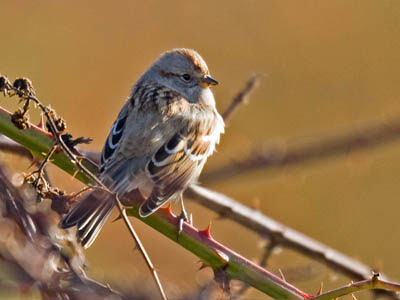 |
|
American Tree Sparrow
Photo by Greg Gillson
|
 |
|
American Tree Sparrow
Photo by Greg Gillson
|
American Tree Sparrow (Spizella arborea)
Range: Breeds in shrubby tundra lands. Winters across northern 2/3 of United States.
Habitat and habits: In winter Tree Sparrows prefers grassy or weedy habitats near trees. Feed on the ground. Often in flocks. Sometimes mix with other sparrows.
Description and voice: Small gray bird with brown back and wings, and darker gray tail. Round head, shorter squared tail. The head is pale gray with rufous crown and line back from the eye. There is a dark spot on the breast. White wing bars.
The song is a clear sweet descending warble. The call is a soft “tweedle.”
Feeder type and food preference: Often feed on the ground under feeder on spilled seeds. Will eat at platform or hopper type feeders. Prefer small seeds such as millet.
Similar species: Chipping Sparrows are darker gray on the face with a black line through the eye starting at the bill. This area, called the lores, is pale on American Tree Sparrow. Clay-colored Sparrows have a brown ear covert and more brownish crown. Field Sparrows come in two colors–a pale gray face with white ring around eye and no rusty line back from eye, or a more buffy-orange colored bird throughout the head and under parts. Of these, the American Tree Sparrow is most likely to actually eat from a bird feeder.
5. White-crowned Sparrow
 |
|
Adult White-crowned Sparrow
Photo by Greg Gillson
|
 |
|
Immature White-crowned Sparrow
Photo by Greg Gillson
|
White-crowned Sparrow (Zonotrichia leucophrys)
Range: Breed across northern Canada, Alaska, and mountains of the West, also lowlands of Pacific Northwest and Coastal California. Winter across lower half of the United Sates well into Mexico. About 5 slightly different varieties, varying in song and plumage. Coastal California form does not migrate.
Habitat and habits: White-crowned Sparrows winter in brushy roadside tangles, feeding on road edges, lawns. Active feeding flocks hop out from cover farther and farther until flock is startled and flee back into brush to start again.
Description and voice: A slightly longer and larger sparrow with long tail. Gray body, brown striped back and wings, dark tail. Adults with striking black and white striped crown. Yellow or pinkish bill. Immatures during their first year are a bit dingier with crown stripes replaced with buff and rufous (see photo above).
The song is highly varied and each locality has its own variation. All are recognized by starting with a drawn out “sweet” note followed by 2 or 3 trills of different speeds, ending in “cheer-cheer” notes, or similar. Call is a sharp “pink!” note.
Feeder type and food preference: White-crowned Sparrows may be slightly more likely to visit feeders in the West than in the East. They used platform or hopper type feeders with a tray. They eat millet and black oil sunflower seeds.
Similar species: See White-throated Sparrow (next), which has a well-outlined white throat and yellow spot on forehead between bill and eyes. Immature Golden-crowned Sparrows (below) are similar to immature White-crowned Sparrows, but White-crowned Sparrows have more and more clearly defined dark and pale head stripes.
6. White-throated Sparrow
 |
|
Tan-striped White-throated Sparrow
Photo by Greg Gillson
|
 |
|
White-striped White-throated Sparrow
Photo by Greg Gillson
|
White-throated Sparrow (Zonotrichia albicollis)
Range: Breed across Canada to northern Midwest States and Northeastern States. In winter from Northeast United States, Southeast, South Central States and Southwest. Rare in Winter across the West.
Habitat and habits: White-throated Sparrows breed in coniferous and mixed forests. They winter they prefer dense woodlands and edge habitats, especially with nearby bird feeders. Often occurs in large flocks. Feed by hopping on the ground in openings near cover. Sing throughout winter, call frequently at dawn and dusk.
Description and voice: Adults can have black and white striped head or brown and white striped head. Immature birds for their first year are rather mottled with brown and white striped head. Throat bright white strongly bordered by dark gray sides of throat and gray or brown upper breast. White-throated Sparrows show a strong yellow spot on the forehead between the bill and eye (supraloral area).
Song “O Canada” or “Ole Sam Peabody” in strident whistle. The call is a very loud sharp “chink!” often noted at dusk.
Feeder type and food preference: Frequent at bird feeders in the East. White-throated Sparrows especially like striped sunflower seeds and hulled sunflower. Peanut kernels and white proso millet are also favorites. Also eat German millet, red proso millet, and black oil sunflowers.
Similar species: Similar to White-crowned Sparrows (see above), but White-throated Sparrows have a very obvious contrasting white throat and yellow spot before the eyes.
7. Golden-crowned Sparrow
 |
|
Breeding plumage adult Golden-crowned Sparrow
Photo by Greg Gillson
|
 |
|
Immature Golden-crowned Sparrow
Photo by Greg Gillson
|
Golden-crowned Sparrow (Zonotrichia atricapilla)
Range: Breed from Alaska south in the mountains of British Columbia. Winter along the West Coast south to Baja, rarely in the interior West to Mexican border.
Habitat and habits: Golden-crowned Sparrows like brushy habitats at the edge of forests often in good-sized flocks. They forage on the ground, hopping. Then they dash for cover when danger is perceived.
Description and voice: Large sparrow, larger than White-crowned Sparrows when seen together. Rather plump and long-tailed, large head, big bill. Very dull and drab, a dirty gray-brown with darker brown streaks on back and wings.
Breeding adults show golden yellow crown with black lateral crown stripes. Immatures show a faint yellow forehead and crown, streaked with brown and diffuse brown lateral crown stripes.
Adults in winter have head patterns and colored mid-way between breeding adult and immature plumage.
Song is a 3-part descending whistle: “Oh, dear, me.” The call is similar to White-crowned Sparrow but softer, “pink!”
Feeder type and food preference: Golden-crowned Sparrows feed on platform and hopper feeders with trays. They eat many kinds of seeds and fruit, including millet and sunflower seeds. They would be more attracted to seeds on the ground or on a low platform feeder.
Similar species: Winter and immature Golden-crowned Sparrows are very similar to immature White-crowned Sparrows. Immature White-crowned Sparrows have more distinctive rust on gray head streaking.
8. Female House Finch
 |
|
Female House Finch
Photo by Greg Gillson
|
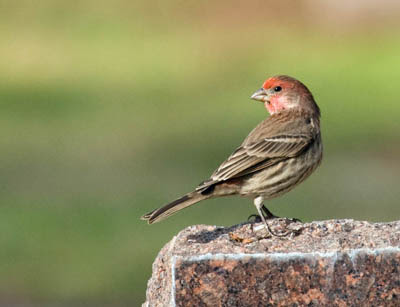 |
|
Male House Finch
Photo by Greg Gillson
|
House Finch (Haemorhous mexicanus)
Range: Resident from southern Canada into Mexico.
Habitat and habits: Found in ranches, residential areas. Also brushy wooded lowlands with openings. Flocking and flying over head. Frequently perches in the tops of scrubby trees. When frightened fly up into trees, not down into bushes as do most sparrows. Nest around buildings. This is probably the most likely little brown bird at your feeder.
Description and voice: A small brown bird; both sexes heavily streaked below. Somewhat slim with small head. Wings are short and tail fairly long and narrow with small notch at end. Adult males have brightest red on forehead, upper breast, and rump. Male’s red or red-orange color often with some individual variation toward orange or even yellowish.
Songs are a cheery whistled warbling ending with a burry scratchy note. Calls are somewhat similar to House Sparrows but less chirping; a rising “chilp.”
Feeder type and food preference: House Finches prefer tube feeders with hulled sunflowers and black oil sunflower seeds.
Similar species: Other striped finches with red-plumaged males include Cassin’s Finch in ponderosa pine forests. Purple Finches are found in fir and mixed forests; winter in lowland woodlands and residential areas.
The male House Finch has brown streaked sides, white the Cassin’s and Purple Finch males have unstreaked pink or purplish (not red-orange) under parts.
Female House Finches have a rather plain unmarked head and face. The pale eyebrow and lower face of the other two finches wrap around the brown ear covert (see photo below of female Purple Finch).
9. Female Purple Finch
 |
|
Female Purple Finch
Photo by Greg Gillson
|
 |
|
Male Purple Finch
Photo by Greg Gillson
|
Purple Finch (Haemorhous purpureus)
Range: Breeds across southern Canada. Year-round resident in Northeastern United States, Southeast Alaska and West Coast to southern California. Winters in Eastern United States, rarer in the West, except where resident.
Habitat and habits: Cool damp conifer forests. Also mixed woods. In winter also lowland woods and residential areas. Tends to forage high in trees. Males sing from top of trees. Frequently found in flocks. Visits bird feeders in winter.
Description and voice: Plump with a large angled head and large bill. Short strongly notched tail. Female Purple Finch is heavily streaked below. Back and wings have a greenish tint. Face strongly patterned. The pale wide eyebrow wraps around the dark ear covert and back to the lower face. Male with clear unstreaked breast and sides. All of upperparts tinged with red–even over the brown wings and back.
The song is a strongly patterned rapid warble: “hurry-little, hurry-little, hurry-little, hup! hup!” The call is a flat “plik!” often given in flight.
Feeder type and food preference: Purple Finches strongly prefer black oil sunflower seeds over all other seeds. They prefer to eat from tube feeders.
Similar species: Cassin’s Finches in ponderosa forest habitat in the West are whiter and cleaner on the under parts. Males more lightly dusted with red, concentrated on the crown. House Finches are slimmer and longer tailed. Female House Finches have plain unpatterned faces. Male House Finches have brown crowns, bright red forehead, upper breast, and rump. They also have heavily streaked sides unlike the male Purple Finch.
10. Female Red-winged Blackbird
 |
|
Female Red-winged Blackbird
Photo by Greg Gillson
|
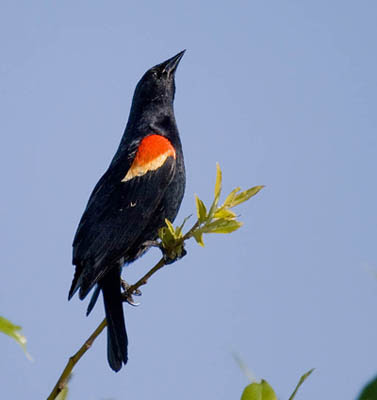 |
|
Male Red-winged Blackbird
Photo by Greg Gillson
|
Red-winged Blackbird (Agelaius phoeniceus)
Range: Year-round resident across the United States and into Mexico. Summer breeder into Alaska and across Canada. These northern birds migrate south in winter to join other resident birds.
Habitat and habits: Nests in cattail marshes and wet fields. Red-winged Blackbirds winter in same habitat as when breeding, but also form huge winter flocks in feedlots and grain fields. Winter flocks may be separated by gender.
Males in spring perch conspicuously. Females often stay low and hidden in marsh vegetation or grasses. Frequently forage on the ground.
Description and voice: Stocky, pot-bellied with a short tail. Bill straight, conical, sharp-pointed. Larger than any sparrow.
Male glossy black with red-orange shoulder edged with yellow.
Female heavily streaked or striped rusty brown, buffy white, gray, and black and frequently mistaken for sparrows by newer bird watchers. Often a pinkish-orange hue on throat.
Immature males are similar, but show some red on shoulder.
Male’s song a bubbly “ong-ka-REE-aa.” Call is a dry “chack” usually given in flight.
Feeder type and food preference: Red-winged Blackbirds eat most bird seed including millet, sunflowers, and cracked corn. They also eat suet. Since they are larger they tend to eat first from the platform feeders.
Similar species: In California Red-winged Blackbirds are joined by the similar Tricolored Blackbirds. Males have darker red shoulders with a white border. Females are blacker overall, with an almost all-black belly.
11. Female Brown-headed Cowbird
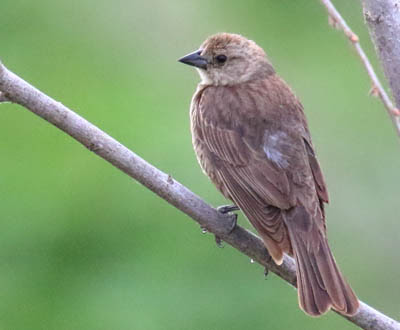 |
|
Female Brown-headed Cowbird
Photo by Greg Gillson
|
 |
|
Male Brown-headed Cowbird
Photo by Greg Gillson
|
Brown-headed Cowbird (Molothrus ater)
Range: Breed across North America (rare in Alaska) south of Arctic. In winter birds migrate out of Canada, the northern Great Plains and interior West.
Habitat and habits: Cowbirds live in open fragmented woods, pasturelands with dotted trees, residential areas. They winter in feedlots and grasslands. May join winter Brewer’s Blackbird flocks in strip mall parking lots. Birds heading north in spring are more likely to show up at backyard bird feeders.
The male display includes the head raised toward sky and wing and tail fanning.
Females lay their eggs in the nests of other smaller birds who raise the cowbird young as their own.
Description and voice: A small blackbird with typical pot belly, short neck, and short tail. Head is flat, bill short and conical; finch-like.
Male glossy black with a green iridescence, brown head.
Female is smaller than the male and evenly pale gray-brown.
Immature birds are paler yet with streaky under parts. Over the fall these pale young birds molt in shockingly black patches of feathers.
Song is a gurgle with rising whistled squeak, “goog-leee,” imitated at times by starlings. Call a flat dry rattle.
Feeder type and food preference: Prefers millet over all other seeds at bird feeder. Eat at platform and hopper feeders with wide trays. Also on the ground.
Similar species: Not many birds with which to confuse. Larger and plainer than House Sparrows. Smaller than other blackbirds. Female buntings (Lazuli, Indigo, Varied Buntings) much smaller with more curved upper ridge to bill, shorter wings. Female Blue Grosbeaks have bigger bills and wing bars, and are more warm rufous.
12. Bewick’s Wren
 |
|
Bewick’s Wren
Photo by Greg Gillson
|
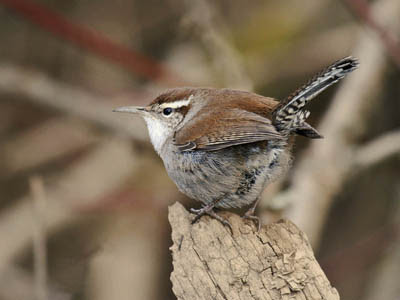 |
|
Bewick’s Wren
Photo by Greg Gillson
|
Bewick’s Wren (Thryomanes bewickii)
Range: Year-round resident on Pacific Coast, southern interior West, to Texas, south into Mexico. Rare in the Mississippi and Ohio River Valleys.
Habitat and habits: Brushy woodlands in a variety of biomes, including chaparral, desert scrub, rain forest clearings, riverside tangles, backyard hedges. Crawls and hops through low tangled vegetation, brush, abandoned structures investigating for insect food.
Description and voice: Smaller than most sparrows. Chubby round body. Neckless. Long thin pointed bill, slightly curved. Long floppy tail often held up over back. Long white eyebrow stripe. Gray under parts. Back and wings brownish, can be reddish-brown or grayer.
Loud song patterned similar to a Song Sparrow with single notes and trills, often a buzzy note. Variable, individual birds have many songs. Flat buzzy call “bjeee,” repeated.
Feeder type and food preference: Feed in bushes at edge of yard. Eats at suet feeder.
Similar species: In the East and Southeast Bewick’s Wren is replaced by the Carolina Wren. It is ruddier with buffy orange under parts, rather than gray. White throat. Long white eyebrow stripe. The House Wren will likely not eat at your bird feeding station, but may nest in an old shed or birdhouse. It is all brown, similar to Bewick’s Wren in shape with shorter tail.
Wrapping Up
We discussed in detail 12 little brown birds that may show up at your feeder or in your backyard. In addition, we briefly mentioned 12 similar species that are also possible. Many other little brown birds live in grasslands and marshes and forests.
The 5 most likely little brown birds at your feeder will probably be House Sparrows, female House Finches, Song Sparrows, White-throated Sparrows, and female Red-winged Blackbirds.
Learn to identify these first.
Yes, they are sometimes harder to identify. But you can do it!
Frequently Asked Questions
Why are House Sparrows so unpopular in the US?
House Sparrows have drawn some negative attention in the US for several reasons:
Competition with native birds: Introduced to North America in the 1850s, House Sparrows readily occupy nesting sites preferred by native cavity-nesting birds like bluebirds and chickadees. Their aggressive tendencies can even result in nest destruction and egg displacement, impacting native bird populations.
Agricultural pests: These opportunistic birds readily feed on grains, fruits, and seeds, leading to crop damage in farms and orchards. Their large numbers can exacerbate the economic impact of their feeding habits.
Negative cultural perception: Often viewed as aggressive and messy, House Sparrows lack the cultural appeal of many native birds. They are sometimes associated with negative connotations like invasiveness and pest-like behavior.
But we think they are just beautiful little songbirds!
What does it mean when a brown bird visits you?
In various cultures and traditions, the appearance of a brown bird can carry different meanings, often based on the specific species, behavior, and context. Here are some possible interpretations, but remember that these are just interpretations and not definitive truths:
- Good luck and fortune: Many cultures associate brown birds with good luck, prosperity, and abundance. Seeing one might be seen as a sign of positive things to come in your life, such as new opportunities, financial success, or good health.
- Guidance and wisdom: Brown birds can be seen as symbols of wisdom and knowledge, similar to owls or eagles. Their appearance could be interpreted as a message to trust your intuition and seek guidance from within.
- Stability and grounding: The earthy tones of brown often symbolize stability, security, and connection to nature. Seeing a brown bird might be seen as a reminder to focus on the grounded aspects of your life and find balance.
- Transformation and change: In some cultures, brown birds represent transformation and change. Their presence could be interpreted as a message to be open to new experiences and embrace personal growth.
What is a very loud small brown bird?
The family of Wrens are known for their loud and persistent calls. There are several species in the US:
- House Wren: These tiny terrors are notorious for their large voices, filling their territories with loud, rapid bursts of song and chatters. They are common in backyards and gardens and are easily identified by their short upturned tails and energetic movements.
- Carolina Wren: Similar to the House Wren but slightly larger, Carolina Wrens also have big voices with loud, clear, melodic songs. They are found in the eastern and southern US and prefer woodland edges and thickets.
- Bewick’s Wren: With a loud, bubbly song and a habit of singing from exposed perches, Bewick’s Wren can often be heard clearly above their size. They are found in the western US and prefer mesquite and scrub habitats.
- Marsh Wren: While not as widespread as other wren species, the Marsh Wren has a surprisingly loud and complex song, with whistles, trills, and gurgling sounds. They are found in wet marshes and wetlands across North America.
Related Articles:
What kind of birds are yellow and black?






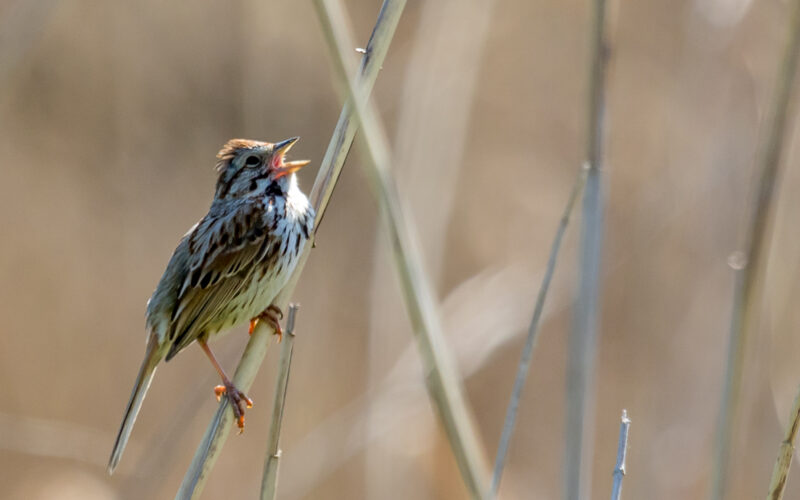




Great post, Greg, thanks. I'm enjoying your new blog. It's interesting how RWBL separate by sex during winter – I wonder how often that occurs in passerines that are not sexually dimorphic and it's just not noticeable?
It feels like we come across female RWBL flocks less often than males. A few days ago we enjoyed watching and listening to a sizable flock of females hanging out near a marshy creek area. They are really pretty birds.
Thanks for visiting my new blog, Miles!
Good question, Miles. Male hummingbirds often precede females by a couple of weeks during spring migration. Other passerines do too (orioles, tanagers, grosbeaks from my experience). I don't know if they segregate on their wintering grounds or not. But birds where males and females are similar? I wonder, too, now!
Come back again!
Greg
Thank you so much for this blog. I just moved into a new house on a Creek and in Little Rock a tributary of Rock Creek. Many many birds so far in the last 2 weeks. But I have one little guy I cannot figure out. I have gone through Peterson's guide to birds and have looked at every page where a 5" or so bird is listed. The head is black and goes into at the base of the neck top of the back a dark Gray otherwise there's no markings. If that makes sense, yeah!
Keep up this blog. I will continue to read here and on your website frequently. I'm looking forward to a wonderful Winter season and Spring with my birds. Thanks so much
Thank you for becoming a regular reader of my new blog, Bonnie!
Your 5 inch long bird with black head and gray body at this time of year seems likely to be a Dark-eyed Junco of some kind. The Slate-colored Junco or "Cassiar" Junco would seem to match.
Excellent info souce. I have tiny brown birds that come to my Norwegian Pine tree. They come as a group and have short tails. Frankly, they are not much bigger than hummingbirds, more round and can hover for short periods. I am trying to take a pic – so far unsuccessful- they are really fast and tiny. Clues?
Hi, Debbie! You didn't say where you lived. But House Sparrows fit the bill(!), or rather the flock with short tails hiding in the pine. Many other species are possible, though.
Thanks for the pictures they helped me with science!
Glad I could help. You know, I started watching birds during 8th grade science… and never stopped!
Thank you Greg! Your pictures are fantastic! They really help in identifying the beautiful birds we get in the backyard right now. Great information as well!
So glad I could help, Michelle!
Thanks, this helped me identify the tree Sparrow
Great job!👍
Ooh. That's a good one!
Glad I could help.
Today I saw a very small (6" beak to tail) brownish bird with very small blackish spots – no pronounced tail. He looked like a minature grown Quail – not a baby – he wasn't fluffy. He was on the small 2 foot gate that I opened to leave a residence in Carlsbad, CA. He did not move. Just stayed perched as I opened and very gently closed the gate. Continued to perch as I walked away and drove off in my car. What was it?
I know what it is!
You may have trouble finding it in your bird books unless they have recently been updated.
These birds are Scaly-breasted Munia, formerly known as Nutmeg Mannikin.
They are goldfinch-sized with big head, short wings, stumpy tail, and thin piping calls. They are usually in small flocks or family groups. Adults have spots or rows of crescents on their breast, immatures do not. I think they breed pretty much year round.
They are the offspring of escaped cage birds. They have become quite common in the coastal lowlands of southern California since the 1980s.
They love to make nests of the white fluffy flowers atop the ornamental pampas grass, often near ponds or creek bottoms.
Wow, Greg! First-year birdwatcher who's moved to a unique riverside spot in NW Wyoming that a haven for resident & migrating wildlife. My field guides get a good workout, but all of my online searches seem to lead to you. I've been reading your blog sporadically for months — it's SO HELPFUL in identifying any new visitors! Thank you for all of your hard work.
Pamela,
You don't know how good your comments make me feel!
I am so grateful to have created a resource that is helpful and that people can easily find online.
I printed your comment out so I can read it daily and give me joy as I continue to write more articles.
Thank you!
We have so many"little brown birds" at our feeders right now, I think, by your information, most are house sparrows. Thanks from Pleasant Grove Utah, I was having trouble figuring it out!
You are welcome, Teenybee. You are probably right.
I have a bird at my feeder who looks like a female house finch, but the top beak curves down and is sharp. Any idea what that is?
The top edge of the bill on House Finch is quite curved.
The bill of a bird is made of the same material as fingernails and sometimes keep growing uncontrollably. I've seen a photo of a woodpecker with one mandible very long and curved up.
So, my guess is that your initial ID is correct, a house finch with some sort of bill anomaly.
I was so glad to find this site.you have helped me to identify so many birds in my back yard here in Williamsburg VA.i
I thank you so much for your bird guide.
That is so wonderful to hear. Thank you for taking the time to let me know!
I LOVE that I found your site! I've been a diehard bird feeder for 20+ years, and have maybe 200 visitors a day enjoy my backyard feeding area. It's fun trying to actually identify (and remember, ha) all the different species and varieties who stop by. Your descriptions are wonderful, and include different nuances that are so helpful in identification. Thank you!
Thanks, Sue! Your feeder area sounds wonderful!
Love it, so much good information. Found the bird I was looking for. Enjoyed, thank you so much!
That helped me figure out what flew into my house trough my window at 7 am
Wonderful! Hope the bird also flew out! 😉